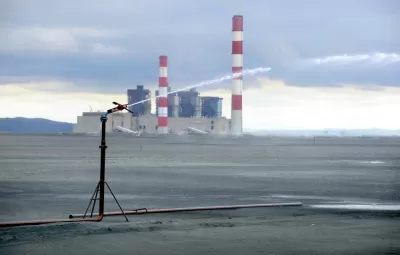At the center of the EPA's newly proposed Affordable Clean Energy rule is doing away with a permitting process known as New Source Review that requires coal power plants to add scrubbers and other expensive pollution control equipment when upgraded.

On Aug. 21, U.S. Environmental Protection Agency Acting Administrator Andrew Wheeler proposed his agency's replacement for President Obama's Clean Power Plan rule: the Affordable Clean Energy (ACE) rule that has been shown would result in up 1,400 premature deaths annually. Several states are expected to sue if the rule becomes law.
"The E.P.A. program at the center of this debate, called the New Source Review, is not well known to the public but it has had an enormous impact over the past two decades on air quality in the United States," reports Eric Lipton for The New York Times. "The basic premise is that anytime a plant expands or becomes a 'new source' of emissions, restrictions kick in."
On the plus side of New Source Review, a 1977 amendment to the Clean Air Act, is the benefit to public health and the environment. On the negative side are the costs that utilities must pay if they upgrade their older plants to make them run more efficiently.
Under current rules, such major retrofits of old plants often come with a big demand: The owners must also spend hundreds of millions of dollars to upgrade the air-pollution equipment to the best available technology, including scrubbers [technically called flue gas desulfurization], a clean-air device that played a major role in ending the acid-rain crisis of the 1970s and that removes millions of tons a year of a pollutant blamed for respiratory disease.
Case in point: Gerald Gentleman Station in Sutherland, Neb., the state’s largest power generating plant which started operating in 1979.
"In recent years, Gerald Gentleman Station has been recognized by Platts Power magazine as the lowest cost coal-fired producer in America," notes Nebraska Public Power District, the state's largest utility that owns and operates the plant which "consists of two coal-fired generating units, which together have the capability to generate 1,365 megawatts of power." The utility doesn't state that the low cost comes at a price.
"The plant lacks both scrubbers for sulfur oxides and what is known as selective catalytic reduction [pdf] for nitrogen oxides," adds Lipton. "As of 2017, its two power units were emitting more than 21,000 tons of sulfur dioxide per year, according to E.P.A. data."
Sulfur oxides are harmful to the human respiratory system, particularly for children, older people and people with asthma. They can also react with other contaminants to create so-called particulate matter, which can penetrate deeply into the lungs and cause additional health problems.
If the ACE rule becomes law, it would enable NPPD to upgrade the plant so as to run more efficiently and extend it's life without spending an estimated $1.5 billion for modern pollution control devices, reports Lipton.
An E.P.A. spokesman, Michael Abboud, defended the policy change, saying in a statement it was designed to benefit the environment and intended “to further encourage efficiency improvements at existing power plants.”
The coal and power plant industries have long been lobbying for changes like this. They argue the current rules discourage them from spending money to make older power plants operate more efficiently because it would also trigger hundreds of millions of dollars in demands for new pollution controls.
Planetizen posts dating back to 2001 and 2002 describe actions by U.S. Environmental Protection Administrator Christine Todd Whitman under President George W. Bush to weaken the rule, though she revealed in her memoir that she had acted on pressure from the administration, particularly Vice President Dick Cheney, to do so.
FULL STORY: E.P.A. Rule Change Could Let Dirtiest Coal Plants Keep Running (and Stay Dirty)

Alabama: Trump Terminates Settlements for Black Communities Harmed By Raw Sewage
Trump deemed the landmark civil rights agreement “illegal DEI and environmental justice policy.”

Study: Maui’s Plan to Convert Vacation Rentals to Long-Term Housing Could Cause Nearly $1 Billion Economic Loss
The plan would reduce visitor accommodation by 25% resulting in 1,900 jobs lost.

Planetizen Federal Action Tracker
A weekly monitor of how Trump’s orders and actions are impacting planners and planning in America.

Grand Rapids Mayor Proposes Garage Conversion Plan
The mayor says allowing homeowners to convert garages to dwelling units could alleviate the city’s housing shortage.

Baltimore Ordered to Improve Sidewalk Accessibility
The city is one of many to face lawsuits for failing to comply with the Americans with Disabilities Act.

This Toronto Suburb Has More Bus Riders Than Columbus, Ohio
Brampton, Ontario used gradual improvements in service to prove that if you build it, they will ride.
Urban Design for Planners 1: Software Tools
This six-course series explores essential urban design concepts using open source software and equips planners with the tools they need to participate fully in the urban design process.
Planning for Universal Design
Learn the tools for implementing Universal Design in planning regulations.
Smith Gee Studio
Alamo Area Metropolitan Planning Organization
City of Santa Clarita
Institute for Housing and Urban Development Studies (IHS)
City of Grandview
Harvard GSD Executive Education
Toledo-Lucas County Plan Commissions
Salt Lake City
NYU Wagner Graduate School of Public Service




























